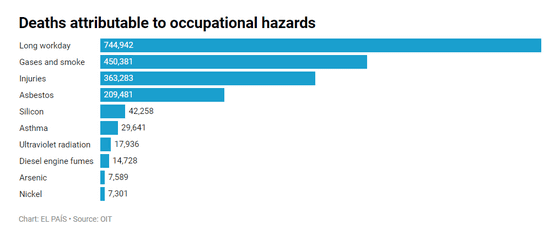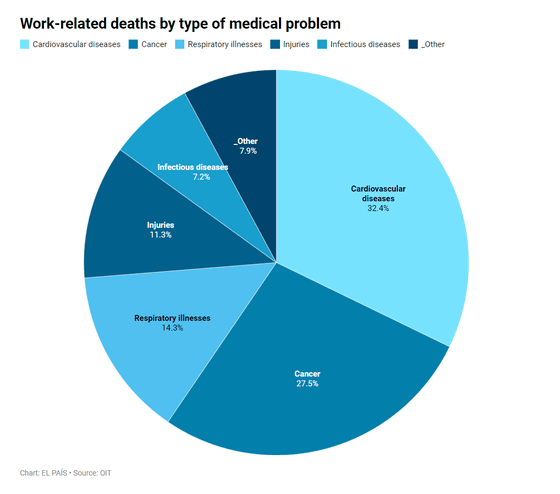Research shows that 750,000 people die each year from working more than 55 hours a week, and men are three times more likely to die from work than women.

It is estimated that approximately 3 million people die each year due to work-related causes. A study published by
Occupational safety and health: Nearly 3 million people die of work-related accidents and diseases
https://www.ilo.org/global/about-the-ilo/newsroom/news/WCMS_902220/lang--en/index.htm
Working more than 55 hours a week kills 750,000 people a year worldwide | Health | EL PAÍS English
https://english.elpais.com/health/2023-11-28/working-more-than-55-hours-a-week-kills-750000-people-a-year-worldwide.html

On November 26, 2023 local time, the ILO released a research report titled ``A Call for a Healthier and Safer Working Environment''. According to this report, the world's population as of 2023 is approximately 395 million people, but it is estimated that approximately 2.96 million workers will die from work-related accidents and illnesses every year. Of these, 2.6 million people died from diseases such as circulatory system problems, cancer, and respiratory diseases, and 330,000 people died from industrial accidents.
The number of work-related deaths among workers is not increasing in proportion to population growth, and the work-related death rate appears to be lower than it was at the beginning of the 21st century. According to ILO research, the number of work-related deaths increased by 12% from 2000 to 2019, while the workforce grew by 26% during the same period. “Diagnostic tools for diseases have improved significantly over the past two decades, resulting in an increase in the number of cases detected,” the ILO notes, noting that advances in technology are making diseases easier to detect and reducing mortality rates. I assumed it had decreased.
The ILO research report, produced in collaboration with the World Health Organization (WHO), links work-related deaths to common risks. The graph below summarizes what kind of risks threaten the lives of workers, and the one that takes the lives of the most workers is 'long workdays' that exceed 55 hours a week. ” (744,942 people). The following are 'Gases and smoke' (450,381 people), 'Injuries' (363,283 people), 'Asbestos' (209,481 people), and 'Silicon'. ' (42,258 people), 'Asthma' (29,641 people), 'Ultraviolet radiation' (17,936 people), 'Diesel engine fumes' (10,000 people). 4,728 people), followed by 'Arsenic' (7,589 people) and 'Nickel' (7,301 people).

The study also links these risks to
Additionally, the incidence of tracheal, bronchial, and lung cancer due to occupational exposure to chromium doubled between 2000 and 2016. Mesothelioma due to asbestos exposure increased by 40%, and non-melanoma skin cancer rates increased by more than 37% from 2000 to 2020. Meanwhile, mortality rates from exposure to particulate matter, gases and fumes, which trigger asthma, have fallen by more than 20%.
32.4% of worker deaths are caused by cardiovascular diseases, 27.5% by cancer, 14.3% by respiratory diseases, 11.3% by injuries, 7.2% by infectious diseases, 3% by asthma, 2.9% by neuropsychiatric diseases, and 0.95%. It has also been revealed that 0.94% have genitourinary diseases, 0.94% have gastrointestinal diseases, and 0.15% have other diseases. Furthermore, according to the report, more than 13 million people around the world 'suffer from work-related visual impairments.'
The graph below shows the medical classification of the cause of death when a worker dies in a work-related manner. The most common cause was ``Cardiovascular diseases'' (32.4%), followed by ``Cancer'' (27.5%), ``Respiratory illnesses'' (14.3%), and ``Injuries''. )” (11.3%), “Infectious diseases” (7.2%), and “Other” (7.9%).

The report shows that work-related deaths account for 6.7% of deaths in one year. By region, the highest work-related death rate is in Africa (7.4%), followed by Asia and the Pacific (7.1%), and Oceania (6.5%). Work-related death rates are said to be low in Europe and the United States, but the ILO does not provide specific figures, nor does it release detailed figures for each country.
According to the ILO, the industries most closely associated with work-related deaths are agriculture, forestry, fishing, mining, construction, and manufacturing, where workers have 'a stable or regular income and adequate legal protection.' It is sounding the alarm on cases that lack 'legal or social protection.' It is also emphasized that the work-related death rate for men is 51.4 per 100,000, while for women it is much lower at 17.2 per 100,000.
Related Posts:
in Science, Posted by logu_ii







